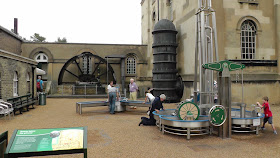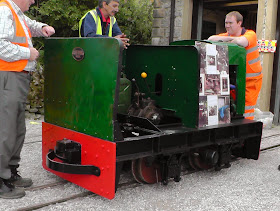In a nutshell
Gauge: 2'
Length: 400 yards
Opened: 2009
Location:
Green Dragon Lane,
Brentford,
Middlesex,
TW8 0EN
Web: http://www.waterandsteam.org.uk/our-engines/waterworks-railway
www.facebook.com/waterandsteam
www.twitter.com/waterandsteam
Date of visit: 6 September 2014
Key Facts
- The railway is situated on the site of the Kew Bridge Water Works which was opened in 1838 with Boulton & Watt and Maudlsay, Sons & Field beam engines to pump the water
- The museum has a collection of ten pumping engines of various sizes and vintages, including the world's largest working beam engine built in 1846
- The museum was refurbished in 2013 and includes an impressive array of interactive educational exhibits designed to inform children and adults about the workings of steam engines and waterworks
- This company did not operate its own internal railway system but when it opened as a museum, a 2' narrow gauge railway was built to represent the type of railway which could be found in other waterworks. Waterworks railways were used to transport coal for the pumping engines and sand for the filter beds
- The railway has two locomotives; a replica Wren locomotive, Thomas Wicksteed, built by Hunslet in 2009 and a 1957 three cylinder internal combustion Lister railmotor, 'Alister'.
- The railway usually runs at weekends when the pumping engines are also in steam - see calendar for more details - http://www.waterandsteam.org.uk/Events/Calendar
- The is a cafe on site which serves a selection of hot food and snacks.
Route
My Impressions
I travelled overland by train from Waterloo to Kew Bridge station and took the short walk around the corner to the museum (see above Google Map). The museum is easily recognisable by the Victorian standpipe tower which dominates the skyline.The building from the outside didn't look particularly inspiring,
but passing inside, through the pleasantly appointed cafe and bookshop.....
...... I immediately encountered the museum's collection of working pumping engines.
At the other end of the train, the railway's Hunslet-built Wren class locomotive, Thomas Wicksteed, was quietly steaming.
I boarded the train and we departed.
We chugged around to the rear of the museum and came to a halt.
Within a short while. Thomas Wicksteed, chuffed around after us and pulled up to couple to the coach.
The driver then opened the regulator and the train set out for the return journey.
We steamed back around the rear of the museum and cruised back beside the platform where we disembarked and had an opportunity to admire the locomotives.
The replica Wren locomotive, constructed in 2009, is a masterpiece of small scale engineering.
Its anatomy is readily accessible. I was particularly interested in the functioning of the injector as this was something I was representing on a 16mm scale model locomotive I was constructing at the time. The driver was happy to not only explain how it worked but to demonstrate its operation which was especially helpful.
Having sated my appetite for narrow gauge rail travel, I turned my attention to the other exhibits in the museum. As a former primary school teacher, I was particularly interested in how the museum's exhibits were presented for a younger audience - and I was not disappointed. As them museum depicts the relationship between water and steam, there is an instant appeal for children which the museum appears to have exploited to the full. In the outdoor area beside the railway, there was a play area where children (and their parents, of course) can play and experiment with water - pumping it, damming it, re-directing it.
Behind this area is a water is the Hindley Water Wheel which was constructed in 1902 to pump water from the River Frome to the Duke of Somerset's estate. It was interesting to see how water power was being used to pump water.
Inside the museum, four of its steam engines were functioning at various intervals during the day.
The Easton and Amos Engine (1863) was quite different to the museum's large Cornish beam engines by having one end of its beam connected to a crank to produce rotary motion rather than the reciprocating motion needed for pumping. This engine came from the Cliftonville Pumping Station in Northampton where it drove a set of pumps from an extension to the crank shaft.
The Hathorn Davey Triple Expansion Engine (1910) shows how steam powered pumping engines developed in the early 20th century. The three cylinders are inverted and placed in a line directly over the crankshaft in much the same way as a modern car engine. It came from a pumping station in Newmarket and was in motion throughout my visit.
The Waddon engine was built by James Simpson & Company in Pimlico in 1910. The high and low pressure cylinders are horizontal with a flywheel between them.
The last engine which I saw functioning during my visit was the The James Kay engine or Dancers End engine, as it came from the Rothschild Dancer's End Estate near Tring. It was used to pump water from a well. The engine was built in 1867 by James Kay of Bury. The engine differs from all the other engines in the museum as it has two high pressure cylinders, each connected to its own beam and crank with a common flywheel. It's though that this engine was originally used in a textile mill and was later converted to pump water.
As the museum hosts the world's largest operating steam engine, I took some time to view the enormous engines which are housed there.
Although they weren't operational on the day I visited, there was plenty of information and video screens showing how the machines worked.
The operational 90 inch Engine was built in 1846 by Sandys, Carne & Vivian of Copperhouse Foundry, Hayle, Cornwall and was the first engine built in Cornwall specially for waterworks duty.
The 100 inch engine was built by Harvey & Co of Hayle in 1869, and is the largest surviving single cylinder beam engine in the world. When it was running it was synchronised with the 90 inch engine. It was used until 1958, when the chimney stack became unsafe and was demolished and the boilers decommissioned.
Before leaving, I quickly toured the other exhibits which seemed extremely well organised, providing visitors with plenty of hands-on experience.
Clearly, a lot of thought has gone into how the exhibits are organised to ensure they are informative and motivating for both adult and child audiences.
I think it's still true to say that children enjoy paling with water. And from my observations, it would seem their parents have just as much interest and enthusiasm to participate in the activities.
I would imagine that children of all ages would be fascinated by many of the features in this museum. And, of course, there is the added bonus of a working narrow gauge railway!
Video
[In preparation]



































































